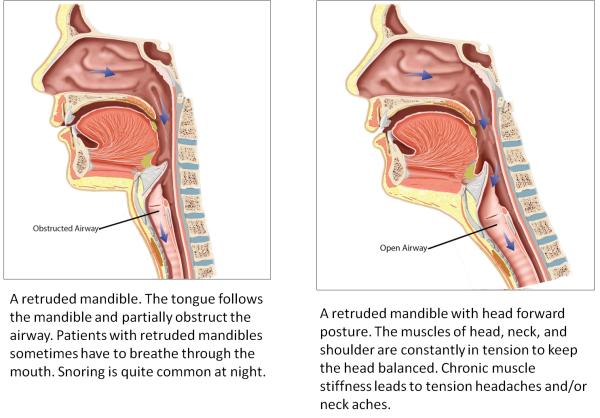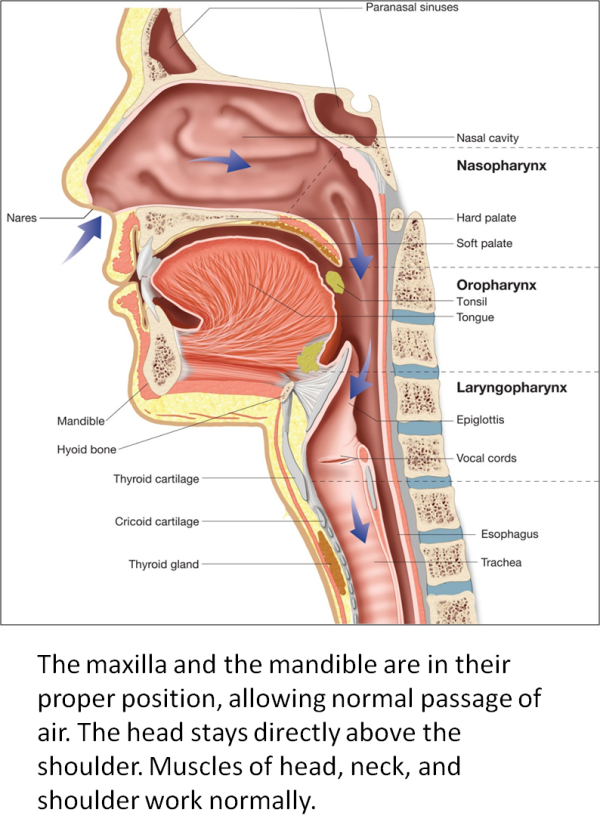Development Of The Maxilla
The human maxilla is part of the skull. It is fixed. The mandible is the only part of the jaw that moves. The mandible must make contact with the maxilla in order for the body to properly digest food, as digestion to provide nutrition for the body must be the number one priority. So if the maxilla is somehow narrow or retruded, the mandible must position itself accordingly. How the maxilla gets developed in the formative years becomes extremely important. Oral habits like thumb sucking, tongue thrust, prolonged use of pacifiers, swallowing pattern etc… can all have adverse effect on the size of the maxilla. The maxilla needs to be in proper size width-wise (i.e. transversely) and length-wise (i.e. sagittally).
There are two (2) scenarios where the maxilla can cause the retrusion of the mandible.
Scenario #1: Maxilla is positioned normal relative to the skull, but the shape of the maxilla arch is narrow or V-shaped. Mandible retrudes to occlude with maxilla.

Scenario #2: Maxilla is retruded relative to the skull, but the shape of the maxilla arch is normal or Oval-shaped. Mandible also retrudes to occlude with maxilla.
In either scenarios, the end result is a retruded mandible with all of its complications. Lateral Cephalometric tracing techniques can be used to determine whether the maxilla is properly positioned relative to the skull.

Airway Obstruction and Large Tongue
A large tongue (Macroglossia)can cause the same airway blockage as the retruded mandible. The patient with large tongue will posture the head forward to open the airway. The head forward posture might result in head, neck, and shoulder stiffness. Headache, neck pain, and numbness on fingers are usually the symptoms. The patient will not have symptoms related to the ears since the mandible is actually not retruded relative to the maxilla. The treatment for this patient is still the same that is to open the airway by moving the mandible and the tongue forward.


Whether it is from a narrow maxilla that leads to the retraction of the mandible (Scenario 1), a retruded maxilla that also leads to a retruded mandible (Scenario 2), or a large tongue; the end effect is the blockage of the airway. The patients will open up the airway by moving the head forward. This forward posturing causes muscle soreness for the head, neck, and shoulder. Tension headache usually follows. Numbness for the fingers can also happen as the stiffness spreads further down the upper back.
The reposition of the mandible forward will help open up the airway and the head will gradually move back to its neutral, balance position directly on top of the shoulder. Chiropractors regularly treat these patients without realizing the main cause of it. They blame it on the excessive use of smart phones, sitting habit, driving position, etc… As soon as the physical therapy stops, the symptoms start to come back. The only permanent solution to treat TMD/Airway Obstruction is to advance the mandible and the tongue forward and open up the airway passage.
TESTIMONIALS
Dear Familycare Dental,
My thanks to your full staff for the courtesy and honesty shown to me in replacing my cap.
Enjoy your morning!
Rob,
Josh and I wanted to personally thank you for assisting us with our dental care. We really appreciate it. Hope you enjoy.
Dear Dr. Tran,
I would like to give my thanks to Dr. Tran and assistant Rose for being so understanding and caring while trying to make me more comfortable. Thank you also, Mr. Levin, for making sure we were taken care of.
Thank you
Dear Robert,
Thank you very much Rob, for helping me out. That meant a lot to me, and I just wanted you to know that I am very greatful. Hope you have a nice day.
